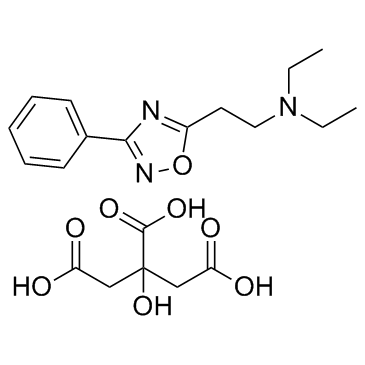CHEMICAL IDENTIFICATION
-
RTECS NUMBER :
-
RO0720000
-
CHEMICAL NAME :
-
1,2,4-Oxadiazole, 5-(2-(diethylamino)ethyl)-3-phenyl-, citrate
-
CAS REGISTRY NUMBER :
-
1949-20-8
-
LAST UPDATED :
-
199712
-
DATA ITEMS CITED :
-
8
-
MOLECULAR FORMULA :
-
C14-H19-N3-O.C6-H8-O7
-
MOLECULAR WEIGHT :
-
437.50
-
WISWESSER LINE NOTATION :
-
T5NO DNJ C2N2&2 ER &QV1XQVQ1VQ
HEALTH HAZARD DATA
ACUTE TOXICITY DATA
-
TYPE OF TEST :
-
LD50 - Lethal dose, 50 percent kill
-
ROUTE OF EXPOSURE :
-
Oral
-
SPECIES OBSERVED :
-
Rodent - rat
-
DOSE/DURATION :
-
1650 mg/kg
-
TOXIC EFFECTS :
-
Details of toxic effects not reported other than lethal dose value
-
REFERENCE :
-
BJPCAL British Journal of Pharmacology and Chemotherapy. (London, UK) V.1-33, 1946-68. For publisher information, see BJPCBM. Volume(issue)/page/year: 16,209,1961
-
TYPE OF TEST :
-
LD50 - Lethal dose, 50 percent kill
-
ROUTE OF EXPOSURE :
-
Intraperitoneal
-
SPECIES OBSERVED :
-
Rodent - rat
-
DOSE/DURATION :
-
351 mg/kg
-
TOXIC EFFECTS :
-
Details of toxic effects not reported other than lethal dose value
-
REFERENCE :
-
FMXXAJ French Medicament Patent Document. (U.S. Patent and Trademark Office, Foreign Patents, Washington, DC 20231) Discontinued. Volume(issue)/page/year: #683M
-
TYPE OF TEST :
-
LD50 - Lethal dose, 50 percent kill
-
ROUTE OF EXPOSURE :
-
Oral
-
SPECIES OBSERVED :
-
Rodent - mouse
-
DOSE/DURATION :
-
650 mg/kg
-
TOXIC EFFECTS :
-
Kidney, Ureter, Bladder - inflammation, necrosis, or scarring of bladder
-
REFERENCE :
-
THERAP Therapie. (Doin, Editeurs, 8, Place de l'Odeon, F-75006 Paris, France) V.1- 1946- Volume(issue)/page/year: 19,631,1964
-
TYPE OF TEST :
-
LD50 - Lethal dose, 50 percent kill
-
ROUTE OF EXPOSURE :
-
Intraperitoneal
-
SPECIES OBSERVED :
-
Rodent - mouse
-
DOSE/DURATION :
-
351 mg/kg
-
TOXIC EFFECTS :
-
Details of toxic effects not reported other than lethal dose value
-
REFERENCE :
-
BJPCAL British Journal of Pharmacology and Chemotherapy. (London, UK) V.1-33, 1946-68. For publisher information, see BJPCBM. Volume(issue)/page/year: 16,209,1961 ** OTHER MULTIPLE DOSE TOXICITY DATA **
-
TYPE OF TEST :
-
TDLo - Lowest published toxic dose
-
ROUTE OF EXPOSURE :
-
Oral
-
SPECIES OBSERVED :
-
Rodent - rat
-
DOSE/DURATION :
-
43400 mg/kg/7W-I
-
TOXIC EFFECTS :
-
Liver - changes in liver weight Kidney, Ureter, Bladder - changes in kidney weight Nutritional and Gross Metabolic - weight loss or decreased weight gain
-
REFERENCE :
-
EMPSAL Experimental and Molecular Pathology, Supplement. (New York, NY) No.1-3, 1963-66. Discontinued. Volume(issue)/page/year: 2,1,1963
-
TYPE OF TEST :
-
TDLo - Lowest published toxic dose
-
ROUTE OF EXPOSURE :
-
Oral
-
SPECIES OBSERVED :
-
Mammal - dog
-
DOSE/DURATION :
-
7177 mg/kg/7W-I
-
TOXIC EFFECTS :
-
Gastrointestinal - changes in structure or function of salivary glands Kidney, Ureter, Bladder - inflammation, necrosis, or scarring of bladder Nutritional and Gross Metabolic - weight loss or decreased weight gain
-
REFERENCE :
-
EMPSAL Experimental and Molecular Pathology, Supplement. (New York, NY) No.1-3, 1963-66. Discontinued. Volume(issue)/page/year: 2,1,1963 ** TUMORIGENIC DATA **
-
TYPE OF TEST :
-
TDLo - Lowest published toxic dose
-
ROUTE OF EXPOSURE :
-
Oral
-
SPECIES OBSERVED :
-
Rodent - rat
-
DOSE/DURATION :
-
15 gm/kg/1Y-I
-
TOXIC EFFECTS :
-
Tumorigenic - Carcinogenic by RTECS criteria Kidney, Ureter, Bladder - Kidney tumors
-
REFERENCE :
-
EMPSAL Experimental and Molecular Pathology, Supplement. (New York, NY) No.1-3, 1963-66. Discontinued. Volume(issue)/page/year: 2,1,1963 ** REPRODUCTIVE DATA **
-
TYPE OF TEST :
-
TDLo - Lowest published toxic dose
-
ROUTE OF EXPOSURE :
-
Subcutaneous
-
DOSE :
-
120 mg/kg
-
SEX/DURATION :
-
female 9-11 day(s) after conception
-
TOXIC EFFECTS :
-
Reproductive - Fertility - post-implantation mortality (e.g. dead and/or resorbed implants per total number of implants) Reproductive - Specific Developmental Abnormalities - musculoskeletal system
-
REFERENCE :
-
ARZNAD Arzneimittel-Forschung. Drug Research. (Editio Cantor Verlag, Postfach 1255, W-7960 Aulendorf, Fed. Rep. Ger.) V.1- 1951- Volume(issue)/page/year: 17,781,1967
|

